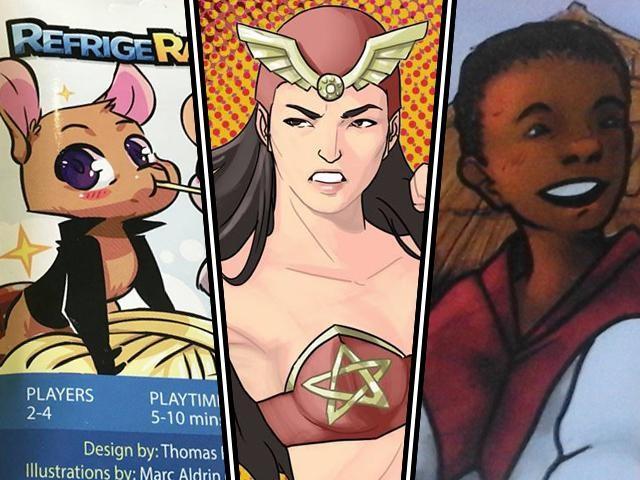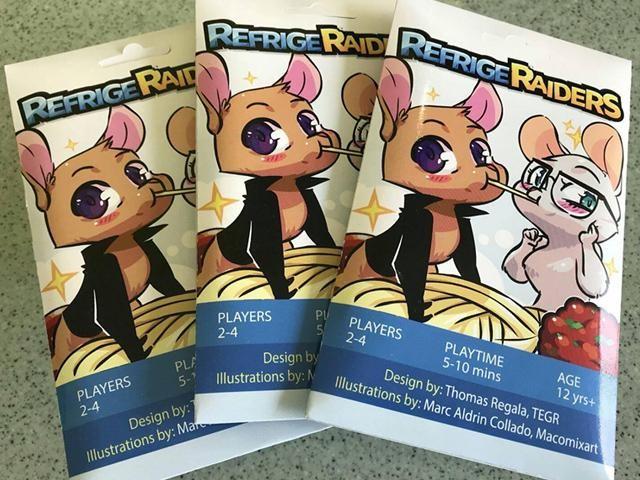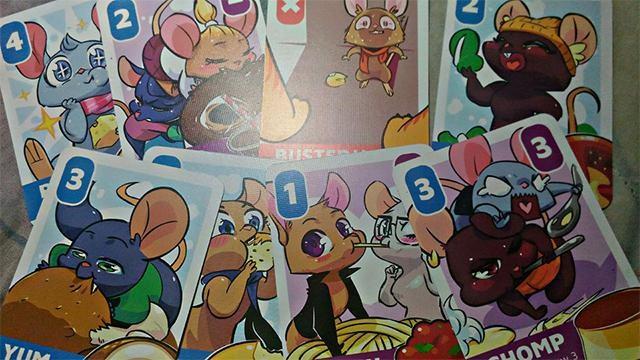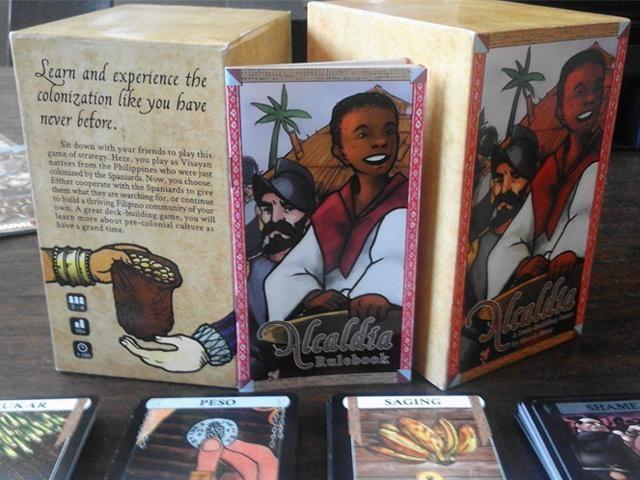3 Pinoy-made card games worth your attention
Soaring interest in tabletop games is inspiring a slew of Filipino designers to create their own. And at the frontline of this tabletop game development charge, sharing the spotlight with board game and role-playing game makers, are the card game developers.
Here are three Pinoy-made card games worth your attention:

1. Refrigeraiders
Thomas Regala of The Epic Gaming Regiment is known for the extremely popular “Hugot.”
Soon, he will also be recognized as the man behind “Refrigeraiders”, a 16-card game for up to four players that he developed in about a week's time.

“It’s a fast-paced game about mice raiding a refrigerator and trying not to get caught,” explained Regala. “Some might wonder how a game with only 16 cards can be played by up to 4 players. But it can be done.”
“I’m not the most technical game designer around,” he admitted. “My games are simple, but they aim at the heart.”
So far, those who’ve played “Refrigeraiders” have enjoyed it, with children particularly drawn to it.
“Kids love it because it’s easy to learn but fun to play. Also, the artwork (by Marc Aldrin Collado) is gorgeous.”
Regala considers it of utmost importance to collaborate with fellow Filipinos when making games.
“As much as possible, everyone I work with is local,” he said. “Printers are local, artists are local, publishers are local. We and other local developers are trying to develop the independent board game scene in the Philippines. It’s very hard work, but someone has to do it, and the benefits definitely outweigh the hardships that we go through.”
Regala hopes to continue promoting indie game developers and artists, and to create more games that will shine a light on Filipino culture and stories.
Taktyl Studios will publish and produce “Refrigeraiders.” They are pushing for it to be officially released this December in time for the holidays. Find its pre-order form here.

2. Alcaldia: the Way Forward
“Alcadia: the Way Forward” started as a Philippine history edutainment tool for high school students. It is a deck-building game set in colonial Philippines, specifically in the aftermath of the 1521 colonization.
“I first designed ‘Alcaldia’ as an Information Design thesis to help make History more engaging to high school students and for them to understand its purpose,” explained Marek.
“The game itself is meant to highlight the things we could have done as a people to ward off the Spanish, because it took us way too long (about 300 years) to act, and it was all too late because by then we would be having a second colonizer.”
“Each player plays a leader of an Alcaldia (the Spanish name for what we now call Barangay), and is faced with two choices: to cooperate with the Spanish to advance the Philippines into a new age, or to build a thriving Filipino community despite the presence of the Spanish,” explained Marek Sison, who co-developed the game with his brother, Ruiz.

The game’s complex mechanics involve managing your resources and Freedom Points. Money can buy Tools, Goods can buy Allies, and both can buy Locations. You can also purchase cards from the center; these cards go to a discard pile that becomes your new deck when your current one runs out of cards.
Players have two goals: (1) the Barangay goal, which tasks you with building a thriving community to achieve a cultural victory, and focuses on Freedom Points. And (2) the Bulawan goal, which has you working towards technological advancement and revolves around producing resources.
Victory goes to anyone who meets either of the two goals.
Marek has always loved game design, and sought every opportunity to make his own games. Then, “a little over 2 years ago, I started making a pirate racing game for kids and that's when I decided that I really wanted to be a game designer.”
While Marek worked in the game industry for experience, he started designing games with Ruiz, who helped him with the mechanics and to see things from a gamer’s perspective. It wasn’t long before they founded Megaladon Games.
Developing “Alcadia: the Way Forward” proved challenging. For one thing, they had to create something that appealed to three markets: hardcore gamers, card game enthusiasts, and high school students. They also had trouble designing the two goals and making the Bulawan goal easier to attain, until Ruiz thought of and eventually helped develop the Locations concept.
Megaladon Games aims to self-publish “Alcadia: the Way Forward.” It will be available online as well as in retail stores. Visit their official Facebook page for more information.
3. Darna at ang Nawawalang Bato
Balangay Entertainment’s “Darna at ang Nawawalang Bato” has been making the rounds, thanks to its quick, snappy gameplay, and of course the beloved heroine at its center. It can be played within 15 minutes by 2 to 4 players.
In the game, players must use observation and guile to be the first to find the missing white stone while preventing others from doing the same.
“Darna at ang Nawawalang Bato” was designed by Marx Rulloda and further developed by Karlo Senga, with art and layout by Aaron Galzote and Aya Cariño-Valdez. In the role of publisher is Balangay Entertainment president Nicanor Valdez.
From the beginning, Balangay Entertainment wanted to make games about Filipino pop culture.
“Since no one else was doing it at the time, we wanted to be the ones to bring our pop culture into the medium of tabletop games,” the team stated. “Naturally, we sought to do a ‘Darna’ game since there may be no bigger Philippine pop culture icon than her.”
The team’s first “Darna” game involved deck-building mechanics. Unfortunately, it proved too complicated for fans of the IP, who have little to no exposure to modern tabletop games. A deck-building card game would also consist of numerous cards, and thus be too expensive.
“That’s when we looked into micro-games like ‘Love Letter’ and ‘Lost Legacy’ because they are very small production-wise, which allowed us to keep the price low.”
One of the team’s missions is to make tabletop gaming affordable to every Filipino. However, getting the price down to PHP 150 was challenging.
“At such a low standard retail price, we had to be meticulous with every cost and component of the game,” they said, adding that releasing the game at the aforementioned price is both a gamble and experiment.
“We’ve yet to see if we can sell enough copies to recoup our development costs. We hope though with such an affordable price the game can really go far and introduce more people to the hobby.”
Of course, making the game easy to learn yet fun was also a difficult process.
“We had to make the game fun for people who have never played anything outside Pusoy Dos and chess and still make it appeal to hardcore gamers.”
Balangay Entertainment is just getting started. They’re currently looking into designing “Captain Barbell,” “Lastikman,” and “Trese” games. A “Darna at ang Nawawalang Bato” expansion is also possible depending on the core game’s sales.
“We’ll probably release the deck-builder version as a free print-n-play,” they added. — LA, GMA News
You can purchase “Darna at ang Nawawalang Bato” at physical board game shops or online via the Balangay Entertainment site.



